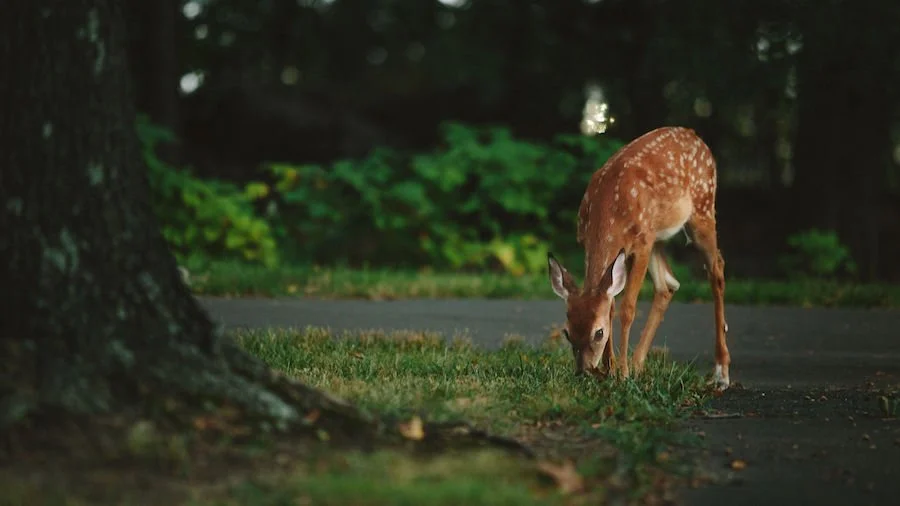Oh Deer, Where are my Plants?
UNFORTUNATELY, DEER CAN’T READ
A long time ago, in a galaxy far, far away… when I was a young landscape contractor experimenting my craft on unsuspecting homeowners I learned a valuable lesson. Deer can’t read; therefore, all the lists that are available to the homeowner and contractor alike cannot be read and understood by the deer population. Ultimately, you will find out that deer actually eat some of the plants that are on the “deer proof list.” There are a multitude of factors that influence the success or lack thereof when we plan landscape plantings in deer country.
DEER FENCING
I once saw a deer try to jump over an eight foot fence and was startled to see that he almost made it. It was an amazing site and I stood in disbelief dumbfounded by what I had just seen. Eight feet is generally considered the fence height required to keep deer off your property. Sorry, but a four or five foot fence is not going to deter a deer that wants to get in. I have seen success when a traditional four or five foot fence is extended by adding eight foot poles to the existing fence posts. Once complete, approximately three wires are then stretched from pole to pole. It is almost invisible from a distance and is usually successful in deterring the deer.
DEER HERDS VARY FROM REGION TO REGION
My first deer planting was in Boonton, New Jersey. I enlisted the help of a Landscape Architect and was actually quite successful. The planting was installed in early fall and the project was in fantastic shape the following spring. In fact, it looked so good a couple from the next street over saw our sign and hired us to do the landscape plantings for their home. Since I was successful with the fall planting, I duplicated the plant list and was on my way to creating a beautiful planting using the same plants, but varied the quantities and arrangement to achieve a different look. Unfortunately, I learned a new lesson: not only did the deer not read, but they also ate plants at this house that they didn’t eat at the house I had landscaped one block over.
PLACEMENT IN THE LANDSCAPE
The actual placement of plantings on your property will affect your success. I believe that the deer are actually quite lazy and will usually take the path of least resistance. Often you can “get away with” planting marginally deer hardy plants closer to the house, by the front door or rear patio. I have also seen evidence that they do not like to stand on hard surfaces like patios or driveways, so you might want to experiment and see what you can get away with in the areas that you think are out of the way. There are also “deer trails” that may run through your property, evidenced by a worn out pathway that may seem hard to detect at first, but should be discernible if you are tuned in. These are the areas of your landscape with which you will be least successful. I suggest you stay with the tried and true varieties of deer hardy plantings.
TIME OF YEAR
The winter is obviously the hardest season for the deer to survive and they will forage on almost anything. There are seasonal variations based on several factors including the harshness of the winter, snow cover, or draught earlier in the season. I often see the damage to evergreens increase in the cold months. Some clients find it necessary to apply deer repellant in the colder months when food for the herd is harder to find. You will see them in places you rarely see them because they are usually more desperate in the winter. Conversely, the summer months allow you to get away with plants in the places that are off the beaten path because there is plenty of food in the easier-to-access locations.
TO COVER OR NOT TO COVER THE SHRUBS
We install landscaping to improve the appearance of our homes, parks, properties etc. for a simple reason: we want to enhance the visual appearance and consequently the visual stimulus/enjoyment we derive from experiencing these spaces. I find absolutely NOTHING visually stimulating from plantings wrapped in brown burlap. Deer netting, on the other hand can provide an effective control without the unattractive and visually disturbing brown burlap. So the answer is yes, you can cover your shrubs in the cold season with deer netting, which should be installed around Thanksgiving and removed a few weeks or so after Easter.
DEER REPELLANT
There are several deer repellants on the market; additionally, there are firms that offer and specialize in deer repellant applications. We discussed earlier that the habits from herd to herd and/or location to location vary considerably. Deer repellants work; however, you may have to experiment until you find the one that works best for your property. Once you find success with a product, you will have to reapply and develop an interval based on your experience, which may also be affected by the amount of precipitation that occurs. The decision to hire a contractor or do it yourself is obviously a personal choice.
THE DISCLAIMER ABOUT THE “DEER PROOF” LIST
If you have read this blog, by now you realize there are no absolutes! It is wise to experiment. Before you invest in a large quantity of plants, invest in a few. Ask your neighbors or call your local garden club to inquire about the local herd.

